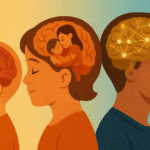Have you ever met someone and, just because they seemed charming or attractive, you immediately assumed they were also intelligent, kind, or competent? That mental shortcut has a name: the Halo Effect. It’s one of the most fascinating cognitive biases in psychology, and it influences us much more than we realize.
What is the Halo Effect?
The Halo Effect is a psychological bias where one positive trait of a person (like appearance, charisma, or eloquence) makes us assume they have other unrelated positive qualities. The term was first studied by psychologist Edward Thorndike in 1920, who noticed that when soldiers rated their superiors, a single positive trait (like being tall or handsome) often influenced the entire evaluation, including competence and leadership.
In other words, our brain creates an “aura” around someone, and that halo colors everything we perceive about them.
Real-life examples of the Halo Effect
This bias is not just theory—it shapes daily life in powerful ways:
- Job interviews: A candidate who looks confident and smiles may be judged as more competent, even if their résumé isn’t the strongest.
- Courtrooms: Studies show that attractive defendants often receive lighter sentences compared to less attractive ones.
- Relationships: If we find someone physically appealing, we might assume they’re also honest, caring, or trustworthy.
- Celebrities: Because someone excels at acting or sports, we assume their opinions on politics or science are valid—when in reality, they’re not experts in those areas.
The Halo Effect shows just how easily first impressions can cloud rational judgment.
Why does the Halo Effect happen?
From an evolutionary perspective, our brains developed shortcuts to save time. Instead of evaluating every detail about a person, we generalize: “If this one thing is good, probably the rest is too.” This quick judgment might have helped in the past, but today it often leads to errors and biases.
The Halo Effect also works in reverse. A single negative trait can create a “horn effect”, where we unfairly assume someone is bad at everything just because of one flaw.
The dangers of the Halo Effect
At first glance, the Halo Effect might seem harmless, but it has serious consequences:
- Companies may hire based on looks or charm rather than skills.
- Students might be graded based on teachers’ personal impressions rather than real performance.
- People in positions of power can manipulate this bias to gain trust or influence without real merit.
Recognizing the Halo Effect is the first step to protecting ourselves from its influence.
How to detect and overcome the Halo Effect
You can’t completely escape this bias—it’s hardwired into the brain—but you can become more aware of it:
- Pause before judging: Ask yourself, “Am I assuming other qualities just because of one first impression?”
- Seek objective evidence: Instead of relying on gut feeling, look at measurable facts—résumés, results, actions.
- Be mindful in relationships: Remember that attraction doesn’t equal kindness, and charm doesn’t equal honesty.
- Flip the perspective: Notice if you’re undervaluing someone because of a negative trait that clouds everything else.
Final reflection
The Halo Effect reminds us of how fragile and biased our perception can be. A smile, a tone of voice, or a single gesture can completely change how we see a person. But once you recognize the bias, you gain power: the power to see people more clearly, beyond the halo.
👉 If you want to explore this topic further, check out our full video on the PsyLife YouTube channel, where we explain the Halo Effect with visual examples and real-life cases.




